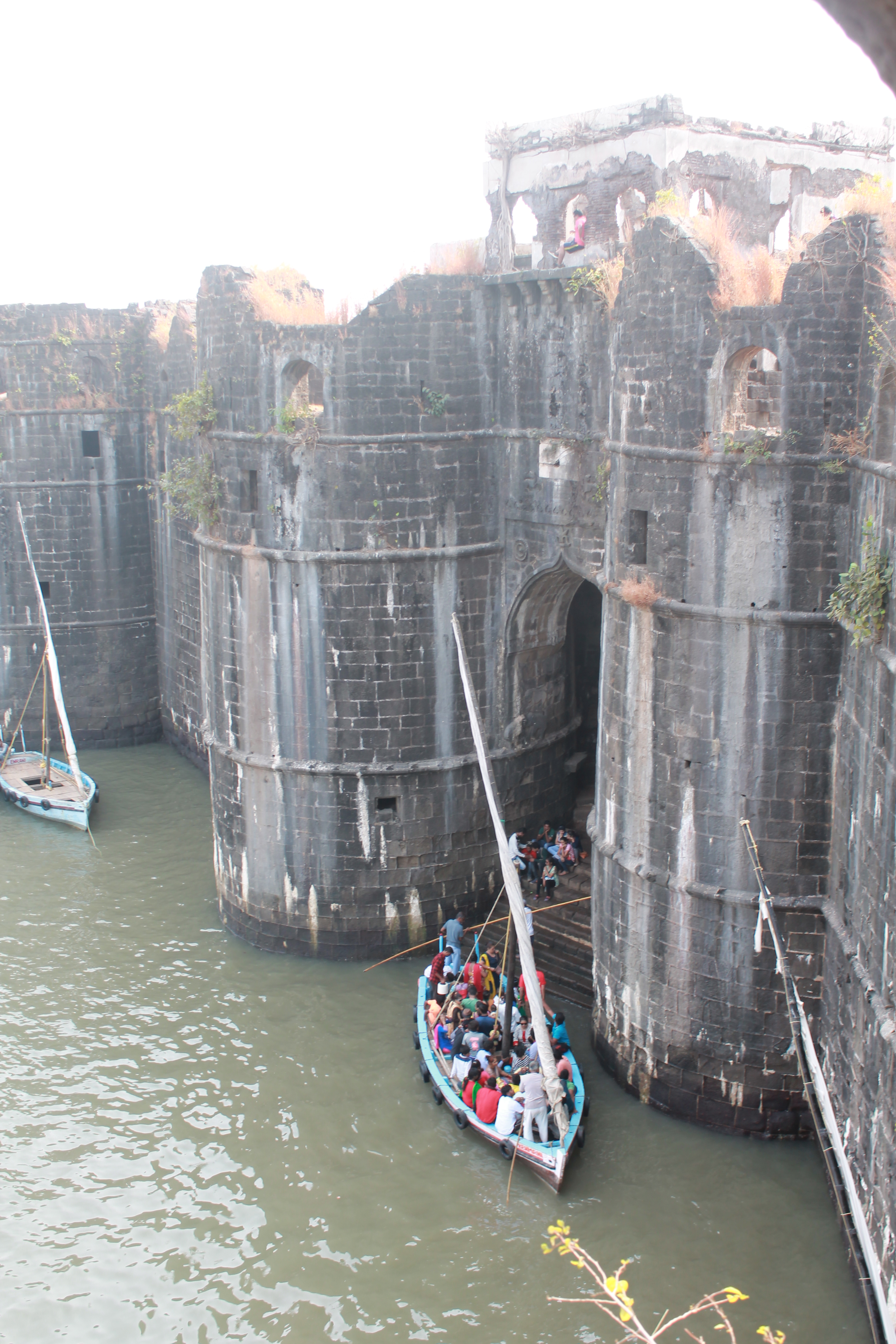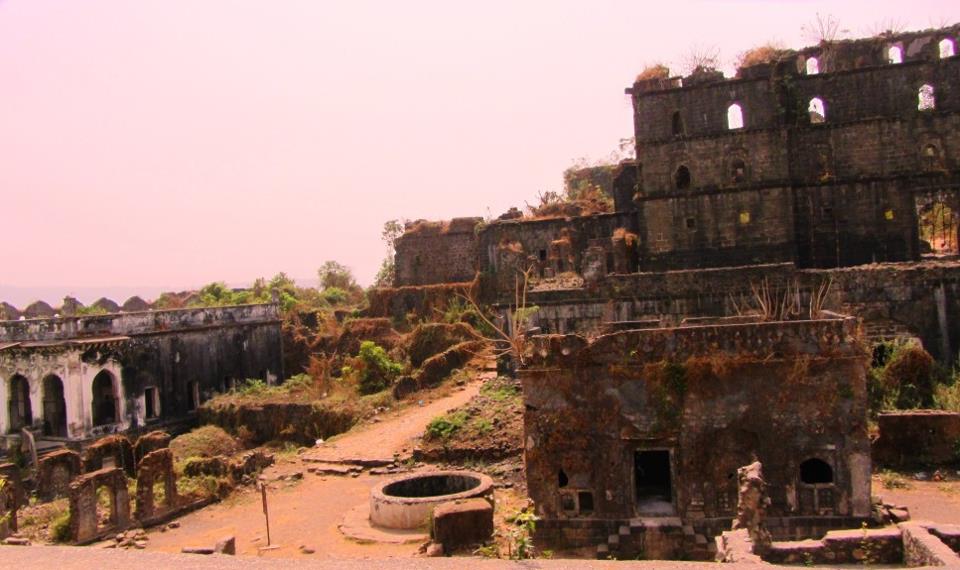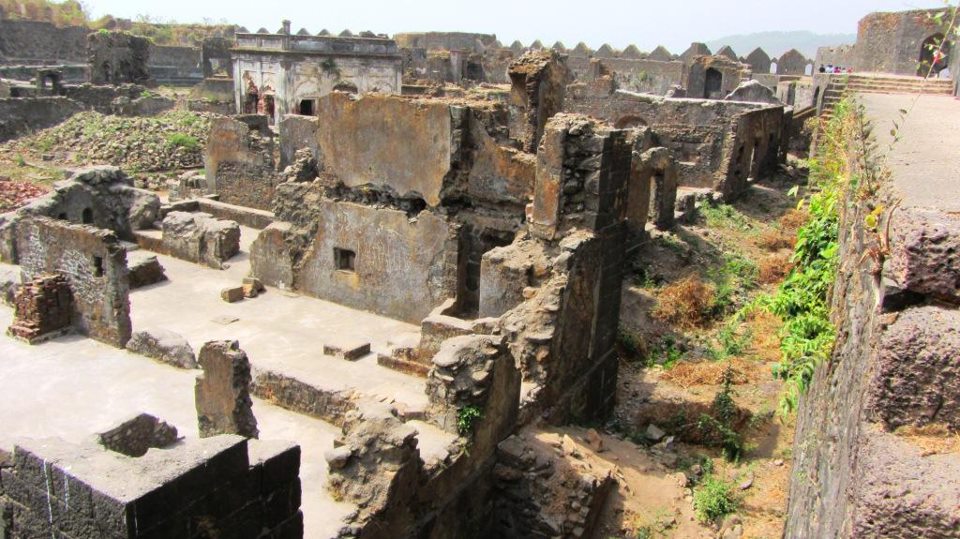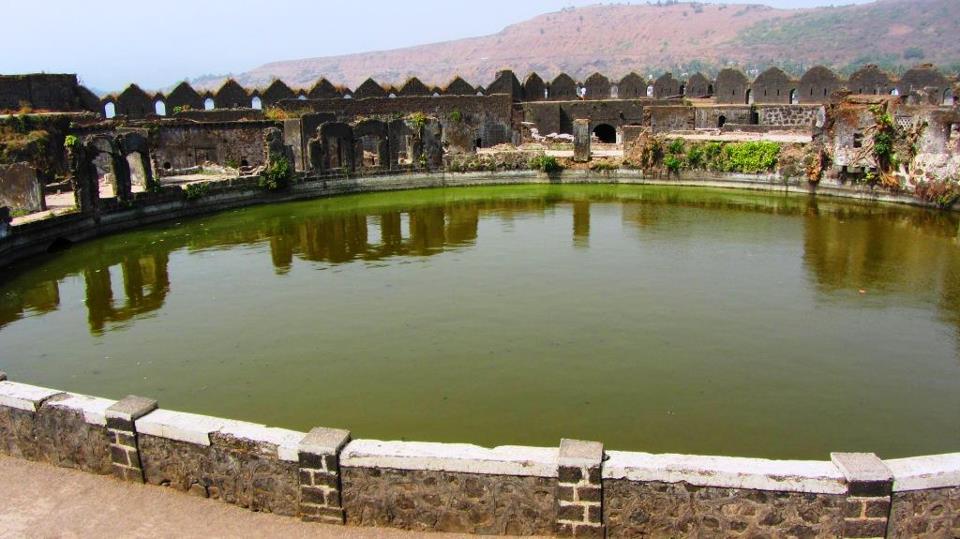Murud-Janjira on:
[Wikipedia]
[Google]
[Amazon]
Murud-Janjira () is the local name of a famous fort and tourist spot situated on an island just off the coastal town of Murud, in the
 The main gate of the fort faces Rajapuri on the shore and can be seen only when one is about away from it. It has a small postern gate towards the open sea for escape.
The main gate of the fort faces Rajapuri on the shore and can be seen only when one is about away from it. It has a small postern gate towards the open sea for escape.
 The fort has 26 artillery towers still intact. There are many cannons of native and European make rusting on the towers. Now in ruins, the fort in its heyday was a full-fledged living fort with all the necessary facilities, such as barracks, quarters for officers, a mosque, two small fresh water ponds and so on. On the outer wall flanking the main gate, there is a sculpture depicting a tiger-like beast clasping elephants in its claws.
The fort has 26 artillery towers still intact. There are many cannons of native and European make rusting on the towers. Now in ruins, the fort in its heyday was a full-fledged living fort with all the necessary facilities, such as barracks, quarters for officers, a mosque, two small fresh water ponds and so on. On the outer wall flanking the main gate, there is a sculpture depicting a tiger-like beast clasping elephants in its claws.
 The palace of the Nawabs of Janjira at Murud is still in good shape.
A special attraction of this fort are 3 gigantic cannons named Kalaal Baangadi, Chavri and Landa Kasam. These cannons were said to be feared for their shooting range. Another gate to the west is sea-facing, called 'Darya Darwaza'.
There is another fortress which is located on top of the hill around east of Murud-Janjira, named Ghosalgad, that was used as an outpost by the rulers of Janjira.
The palace of the Nawabs of Janjira at Murud is still in good shape.
A special attraction of this fort are 3 gigantic cannons named Kalaal Baangadi, Chavri and Landa Kasam. These cannons were said to be feared for their shooting range. Another gate to the west is sea-facing, called 'Darya Darwaza'.
There is another fortress which is located on top of the hill around east of Murud-Janjira, named Ghosalgad, that was used as an outpost by the rulers of Janjira.
 During its heyday, the island fort boasted 572 cannons.
Visitors can gain access to the Janjira fort from Rajapuri, a small village on the coast. After a short ride in a small boat, one can enter the fort through the main entrance. The fort is oval shaped instead of the usual oblong or square shape. The fort wall is about 40 feet high and has 19 rounded porches or arches, some of which still have cannons mounted on them, including the famous cannon Kalaal Baangadi. These cannons were greatly responsible for repelling oncoming enemies from the sea. Inside the fort walls are the ruins of a mosque, a palace and bath with water channelled from streams. There is evidence that royal ladies occupied quarters here. A deep well, still functional, provides fresh water despite the fort being surrounded by salt water.
On the island's outer wall is a luxurious mansion, the Palace of the Nawab. Built by the former Nawab of Janjira, it commands a panoramic view of the Arabian sea and the Janjira sea fort.
During its heyday, the island fort boasted 572 cannons.
Visitors can gain access to the Janjira fort from Rajapuri, a small village on the coast. After a short ride in a small boat, one can enter the fort through the main entrance. The fort is oval shaped instead of the usual oblong or square shape. The fort wall is about 40 feet high and has 19 rounded porches or arches, some of which still have cannons mounted on them, including the famous cannon Kalaal Baangadi. These cannons were greatly responsible for repelling oncoming enemies from the sea. Inside the fort walls are the ruins of a mosque, a palace and bath with water channelled from streams. There is evidence that royal ladies occupied quarters here. A deep well, still functional, provides fresh water despite the fort being surrounded by salt water.
On the island's outer wall is a luxurious mansion, the Palace of the Nawab. Built by the former Nawab of Janjira, it commands a panoramic view of the Arabian sea and the Janjira sea fort.
 In 1539, According to accounts written by the Portuguese admiral Fernão Mendes Pinto, the Ottoman fleet that first arrived in
In 1539, According to accounts written by the Portuguese admiral Fernão Mendes Pinto, the Ottoman fleet that first arrived in 
 In the year 1736, the Siddis of Murud-Janjira set out in a battle with the forces of the Peshwa Baji Rao. On 19 April 1736, the Maratha warriors Nanaji Surve and Chimaji Appa attacked the gathering forces in the encampments of the Siddis near Rewas. Chimaji Appa advised Siddi Sat to run from battle field otherwise Nanajirao will have no mercy on him but Siddi Sat captured Nanajirao Surve and took him to Sagargad fort. Nanajirao rescued himself and beheaded Siddi Sat along with his entire family and his army. Nanajirao Surve was rewarded with village name Kusgao Advance Study in the History of Modern India (Volume-1: 1707-1803) By G.S.Chhabra When the confrontation ended, 1,500 Siddis, including their leader Siddi Sat, had been killed. Peace was brokered in September 1736, but the Siddis were confined to only Janjira, Gowalkot, and Anjanvel, with their power greatly reduced. However, Janjira remained unconquered until it became part of Indian territory after independence from the British in 1947.
In the year 1736, the Siddis of Murud-Janjira set out in a battle with the forces of the Peshwa Baji Rao. On 19 April 1736, the Maratha warriors Nanaji Surve and Chimaji Appa attacked the gathering forces in the encampments of the Siddis near Rewas. Chimaji Appa advised Siddi Sat to run from battle field otherwise Nanajirao will have no mercy on him but Siddi Sat captured Nanajirao Surve and took him to Sagargad fort. Nanajirao rescued himself and beheaded Siddi Sat along with his entire family and his army. Nanajirao Surve was rewarded with village name Kusgao Advance Study in the History of Modern India (Volume-1: 1707-1803) By G.S.Chhabra When the confrontation ended, 1,500 Siddis, including their leader Siddi Sat, had been killed. Peace was brokered in September 1736, but the Siddis were confined to only Janjira, Gowalkot, and Anjanvel, with their power greatly reduced. However, Janjira remained unconquered until it became part of Indian territory after independence from the British in 1947.
File:Janjira fort - panoramio.jpg, Janjira fort - panorama
File:Murud-Janjira Fort near Murud Raigad Maharashtra DPP 0093 (1).JPG, Inside complex of Janjira fort
File:Janjira Fort bastions 3.jpg, Bastion of Janjira fort
{{Authority control Konkan Princely states of India Islands of Maharashtra 1490 establishments in Asia 15th-century establishments in India Sea forts Forts in Raigad district Populated places in India Islands of India
Raigad district
Raigad district (), previously Colaba fort, Colaba district, is a district in the Konkan division of Maharashtra, India.
The headquarters of the district is Alibag. Other major cities in the district are Panvel, Karjat, Navi Mumbai, Khopoli, Sh ...
of Maharashtra
Maharashtra () is a state in the western peninsular region of India occupying a substantial portion of the Deccan Plateau. It is bordered by the Arabian Sea to the west, the Indian states of Karnataka and Goa to the south, Telangana to th ...
, India
India, officially the Republic of India, is a country in South Asia. It is the List of countries and dependencies by area, seventh-largest country by area; the List of countries by population (United Nations), most populous country since ...
. Malik Ambar is credited with the construction of the Janjira Fort in the Murud Area of present-day Maharashtra
Maharashtra () is a state in the western peninsular region of India occupying a substantial portion of the Deccan Plateau. It is bordered by the Arabian Sea to the west, the Indian states of Karnataka and Goa to the south, Telangana to th ...
India. After its construction in 1567 AD, the fort was key to the Sidis withstanding various invasion attempts by the Marathas
The Maratha Empire, also referred to as the Maratha Confederacy, was an early modern India, early modern polity in the Indian subcontinent. It comprised the realms of the Peshwa and four major independent List of Maratha dynasties and states, Ma ...
, Mughals, and Portuguese to capture Janjira.
Origins of the name
The word Janjira is a corruption of the word "jazira", which means "island" in the Arabic language. Murud was once known in Marathi as ''Habsan'' ("of the Habshi", that is, the Abyssinians). The name of the fort is a concatenation of theKonkani __NOTOC__
Konkani may refer to:
Language
* Konkani language is an Indo-Aryan language spoken in the Konkan region of India.
* Konkani alphabets, different scripts used to write the language
**Konkani in the Roman script, one of the scripts used to ...
and Marathi words, "murud" and "Janjiri". The word "morod" is peculiar to Konkani and is absent in Marathi.
Itbarrao Koli & Malik Ambar of Janjira
Itbarrao Koli was the Patil of Janjira Island and a chief of the Kolis who built this island in the 15th century for Kolis to live on peacefully away from pirates. The origin the old Wooden Garrison can be traced down to the fifteenth century when some local fishermen of Rajapuri constructed a small wooden fort on a huge rock to protect themselves and their families from the pirates. However, the Nizam Shahi Sultan of Ahmadnagar Sultanate wanted to capture this wooden garrison purely for strategic reasons, and when his general Piram Khan captured it, Malik Ambar—his spokesperson who was also an Abyssinian regent of Siddi origin—decided to construct a solid rock fortress in place of the original wooden structure. This fort was originally called Jazeera Mahroob Jazeera.Major features
Murud-Janjira Fort is situated on an oval-shaped rock off the Arabian Sea coast near the port city of Murud, south ofMumbai
Mumbai ( ; ), also known as Bombay ( ; its official name until 1995), is the capital city of the Indian state of Maharashtra. Mumbai is the financial capital and the most populous city proper of India with an estimated population of 12 ...
, in the middle of the western Indian coastline. Janjira is considered one of the strongest coastal forts in India. The fort is approached by sailboats from Rajapuri jetty.  The main gate of the fort faces Rajapuri on the shore and can be seen only when one is about away from it. It has a small postern gate towards the open sea for escape.
The main gate of the fort faces Rajapuri on the shore and can be seen only when one is about away from it. It has a small postern gate towards the open sea for escape.
 The fort has 26 artillery towers still intact. There are many cannons of native and European make rusting on the towers. Now in ruins, the fort in its heyday was a full-fledged living fort with all the necessary facilities, such as barracks, quarters for officers, a mosque, two small fresh water ponds and so on. On the outer wall flanking the main gate, there is a sculpture depicting a tiger-like beast clasping elephants in its claws.
The fort has 26 artillery towers still intact. There are many cannons of native and European make rusting on the towers. Now in ruins, the fort in its heyday was a full-fledged living fort with all the necessary facilities, such as barracks, quarters for officers, a mosque, two small fresh water ponds and so on. On the outer wall flanking the main gate, there is a sculpture depicting a tiger-like beast clasping elephants in its claws.
 The palace of the Nawabs of Janjira at Murud is still in good shape.
A special attraction of this fort are 3 gigantic cannons named Kalaal Baangadi, Chavri and Landa Kasam. These cannons were said to be feared for their shooting range. Another gate to the west is sea-facing, called 'Darya Darwaza'.
There is another fortress which is located on top of the hill around east of Murud-Janjira, named Ghosalgad, that was used as an outpost by the rulers of Janjira.
The palace of the Nawabs of Janjira at Murud is still in good shape.
A special attraction of this fort are 3 gigantic cannons named Kalaal Baangadi, Chavri and Landa Kasam. These cannons were said to be feared for their shooting range. Another gate to the west is sea-facing, called 'Darya Darwaza'.
There is another fortress which is located on top of the hill around east of Murud-Janjira, named Ghosalgad, that was used as an outpost by the rulers of Janjira.
 During its heyday, the island fort boasted 572 cannons.
Visitors can gain access to the Janjira fort from Rajapuri, a small village on the coast. After a short ride in a small boat, one can enter the fort through the main entrance. The fort is oval shaped instead of the usual oblong or square shape. The fort wall is about 40 feet high and has 19 rounded porches or arches, some of which still have cannons mounted on them, including the famous cannon Kalaal Baangadi. These cannons were greatly responsible for repelling oncoming enemies from the sea. Inside the fort walls are the ruins of a mosque, a palace and bath with water channelled from streams. There is evidence that royal ladies occupied quarters here. A deep well, still functional, provides fresh water despite the fort being surrounded by salt water.
On the island's outer wall is a luxurious mansion, the Palace of the Nawab. Built by the former Nawab of Janjira, it commands a panoramic view of the Arabian sea and the Janjira sea fort.
During its heyday, the island fort boasted 572 cannons.
Visitors can gain access to the Janjira fort from Rajapuri, a small village on the coast. After a short ride in a small boat, one can enter the fort through the main entrance. The fort is oval shaped instead of the usual oblong or square shape. The fort wall is about 40 feet high and has 19 rounded porches or arches, some of which still have cannons mounted on them, including the famous cannon Kalaal Baangadi. These cannons were greatly responsible for repelling oncoming enemies from the sea. Inside the fort walls are the ruins of a mosque, a palace and bath with water channelled from streams. There is evidence that royal ladies occupied quarters here. A deep well, still functional, provides fresh water despite the fort being surrounded by salt water.
On the island's outer wall is a luxurious mansion, the Palace of the Nawab. Built by the former Nawab of Janjira, it commands a panoramic view of the Arabian sea and the Janjira sea fort.
History
In early 1100 AD, the Abyssinian Sidis established the Janjira and Jafarabad state. In 1539, According to accounts written by the Portuguese admiral Fernão Mendes Pinto, the Ottoman fleet that first arrived in
In 1539, According to accounts written by the Portuguese admiral Fernão Mendes Pinto, the Ottoman fleet that first arrived in Aceh
Aceh ( , ; , Jawi script, Jawoë: ; Van Ophuijsen Spelling System, Old Spelling: ''Atjeh'') is the westernmost Provinces of Indonesia, province of Indonesia. It is located on the northern end of Sumatra island, with Banda Aceh being its capit ...
(prior to the Ottoman expedition to Aceh led by Kurtoğlu Hızır Reis), included 200 Malabar sailors from Janjira to aid the region of Batak and Maritime Southeast Asia
Maritime Southeast Asia comprises the Southeast Asian countries of Brunei, Indonesia, Malaysia, the Philippines, Singapore, and East Timor.
The terms Island Southeast Asia and Insular Southeast Asia are sometimes given the same meaning as ...
. Later, in 1621, the Siddis of Janjira became exceptionally powerful as an autonomous state to the point that the commander of Janjira, Siddi Ambar the Little, successfully defied his overlord Malik Ambar's attempt to replace him. Siddi Ambar the Little is accordingly considered the first Nawab of Janjira state.
The island fortress was under control of the Adil Shahi dynasty of Bijapur Sultanate until the reign of Ibrahim II when the Janjira fort was lost to the Siddis. Major historical figures from Murud-Janjira include men such as Sidi Hilal, Yahya Saleh and Sidi Yaqub.
In the late 1600's, during the rule of the Mughal emperor Aurangzeb, Sidi Yaqut received a subsidy of 400,000 rupees. He also owned large ships which weighed 300–400 tons. According to records, these ships were unsuitable for fighting on the open sea against European warships, but their size allowed for transporting soldiers for amphibious operations.
Despite repeated attempts by the Portuguese, the British and the Maratha
The Marathi people (; Marathi: , ''Marāṭhī lōk'') or Marathis (Marathi: मराठी, ''Marāṭhī'') are an Indo-Aryan ethnolinguistic group who are native to Maharashtra in western India. They natively speak Marathi, an Indo-A ...
to subdue the island fortress, all of these efforts failed to displace the island's Siddi rulers. The Siddis were themselves allied with the Mughal Empire
The Mughal Empire was an Early modern period, early modern empire in South Asia. At its peak, the empire stretched from the outer fringes of the Indus River Basin in the west, northern Afghanistan in the northwest, and Kashmir in the north, to ...
.
One example of such a failed attack was the account of the 10,000 soldiers who were sent by the Maratha Peshwa
The Peshwa was the second highest office in the Maratha Empire, next in rank and prestige only to that of the Chhatrapati. Initially serving as the appointed prime minister in the Maratha Kingdom, the office became hereditary when Shahu gave t ...
Moropant Trimbak Pingle, and who were roundly repulsed by the Janjira army in 1676. During this Maratha
The Marathi people (; Marathi: , ''Marāṭhī lōk'') or Marathis (Marathi: मराठी, ''Marāṭhī'') are an Indo-Aryan ethnolinguistic group who are native to Maharashtra in western India. They natively speak Marathi, an Indo-A ...
assault, the Marathas, led by chatrapati Shivaji Maharaj, attempted to scale the granite
Granite ( ) is a coarse-grained (phanerite, phaneritic) intrusive rock, intrusive igneous rock composed mostly of quartz, alkali feldspar, and plagioclase. It forms from magma with a high content of silica and alkali metal oxides that slowly coo ...
walls but failed in their attempts. Chatrapati Shivaji maharaj's son Chatrapati Sambhaji Maharaj even attempted to tunnel his way into the fort and was very close to capturing the fort. His attempt was thwarted when a Mughal army attacked the Maratha capital city, forcing Sambhaji to withdraw his forces from the siege and return to the Maratha capital. He built another sea fort in 1676, known as Padmadurg or Kasa fort, to challenge Janjira. It is located northwest of Janjira. Padmadurg took 22 years to build and is constructed on 22 acres of land.

 In the year 1736, the Siddis of Murud-Janjira set out in a battle with the forces of the Peshwa Baji Rao. On 19 April 1736, the Maratha warriors Nanaji Surve and Chimaji Appa attacked the gathering forces in the encampments of the Siddis near Rewas. Chimaji Appa advised Siddi Sat to run from battle field otherwise Nanajirao will have no mercy on him but Siddi Sat captured Nanajirao Surve and took him to Sagargad fort. Nanajirao rescued himself and beheaded Siddi Sat along with his entire family and his army. Nanajirao Surve was rewarded with village name Kusgao Advance Study in the History of Modern India (Volume-1: 1707-1803) By G.S.Chhabra When the confrontation ended, 1,500 Siddis, including their leader Siddi Sat, had been killed. Peace was brokered in September 1736, but the Siddis were confined to only Janjira, Gowalkot, and Anjanvel, with their power greatly reduced. However, Janjira remained unconquered until it became part of Indian territory after independence from the British in 1947.
In the year 1736, the Siddis of Murud-Janjira set out in a battle with the forces of the Peshwa Baji Rao. On 19 April 1736, the Maratha warriors Nanaji Surve and Chimaji Appa attacked the gathering forces in the encampments of the Siddis near Rewas. Chimaji Appa advised Siddi Sat to run from battle field otherwise Nanajirao will have no mercy on him but Siddi Sat captured Nanajirao Surve and took him to Sagargad fort. Nanajirao rescued himself and beheaded Siddi Sat along with his entire family and his army. Nanajirao Surve was rewarded with village name Kusgao Advance Study in the History of Modern India (Volume-1: 1707-1803) By G.S.Chhabra When the confrontation ended, 1,500 Siddis, including their leader Siddi Sat, had been killed. Peace was brokered in September 1736, but the Siddis were confined to only Janjira, Gowalkot, and Anjanvel, with their power greatly reduced. However, Janjira remained unconquered until it became part of Indian territory after independence from the British in 1947.
Gallery
See also
* Murud * List of Indian Princely States * List of forts in Maharashtra * Khokri Tombs * Janjira State * Jafarabad State * Maratha Navy * Siege of JanjiraSources
* Imperial Gazetteer of India, 2. A., 26 Bde., Oxford 1908–1931 * Malleson, G. B.: ''An Historical Sketch of the Native States of India'', London 1875, Reprint Delhi 1984 * Schwartzberg, Joseph E., Hrsg.: ''A Historical Atlas of South Asia'', 2. A., New York/Oxford 1992, * http://www.maharashtratourism.gov.in/MTDC/HTML/MaharashtraTourism/TouristDelight/Forts/Forts.aspx?strpage=Murud_JanjiraForts.html Maharashtra - Murud Janjira Forts Official Govt. PageReferences
External links
Short BBC video on the for{{Authority control Konkan Princely states of India Islands of Maharashtra 1490 establishments in Asia 15th-century establishments in India Sea forts Forts in Raigad district Populated places in India Islands of India